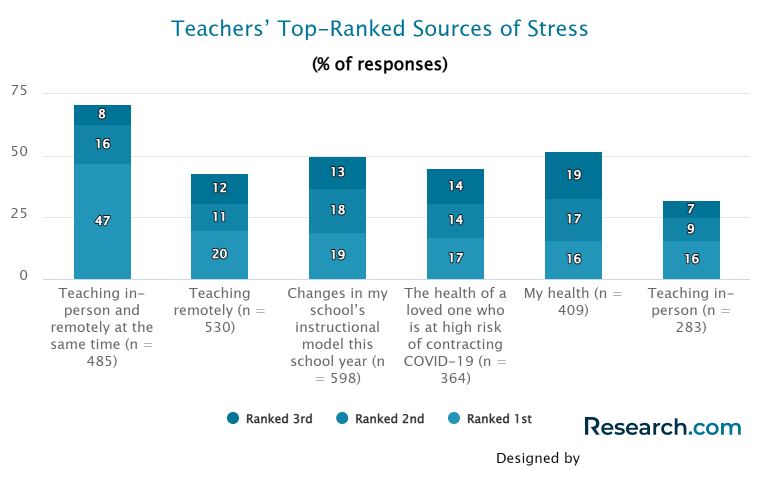
People say teaching is a noble profession, and while that is true, there is another side to it – the side that faces a lot of challenges. Burnout is a growing problem for teachers.
Burnout is a growing problem for teachers. First, it was the pandemic that brought structural and other changes for teachers, and now it’s the NEP (National Education Policy) that is going to change the education structure, design, content, and assessment, which is good for students, but it will bring about new challenges for teachers. This is already causing teachers undue stress and anxiety.
Addressing burnout in Teachers
is important, for they are responsible for teaching and shaping the young minds of tomorrow. This blog is for you if you want to know and understand teacher burnout, its causes, signs, and prevention strategies. So, let’s get started!
What Does Burnout Mean?
According to the World Health Organization (WHO), burnout is a syndrome resulting from chronic workplace stress that hasn’t been successfully managed. It’s characterized by three dimensions:
- Feelings of energy depletion or exhaustion
- Increased mental distance from one’s job, or feelings of negativism or cynicism related to one’s job
- Reduced professional efficacy.
What Causes Teacher Burnout? Addressing Stress Points
Teacher burnout results from a variety of factors including the constant changes in the education system. Besides that, there are other factors that have been a constant presence, let’s look into them.

Heavy Workload
It goes without saying that all professions come with their responsibilities, and teaching is not an exception. But when their work becomes overwhelming to the point of exhaustion, that’s when you know they have a heavy workload.
In addition to managing the classroom, teachers today are expected to organize class rooms, manage the student’s needs, coordinate extracurricular activities, handle administrative tasks, and hold parent-teacher conferences.
Furthermore, these factors impact teachers’ quality both in and outside the classroom as they have difficulties balancing life and work. Stress and fatigue negatively affect teachers’ mental and physical health, which in turn affects their performance and dedication to teaching. For instance, fatigue can lead to teachers making more mistakes while teaching, such as incorrectly grading assignments or overlooking important concepts.
Lack of Support
Teachers need professional development and training to keep up with the rapidly changing education landscape to utilize edtech tools effectively. In an environment like this, teachers may find it challenging to stay motivated.
Dealing with Student Behavior
Managing multiple classrooms and students can be emotionally draining for teachers. This is when they have to deal with loud, disruptive students every day.
Teachers spend a lot of time and energy planning to create lessons that are engaging and informative but when students aren’t paying attention or are disrupting class, it can make them feel demoralized .
Administrative Demands
Another significant cause of teacher burnout is the overwhelming administrative demands. Teachers are often required to maintain parent-teacher relationships, complete daily paperwork related to students, create assessment reports, performance reports, and more.
Adding these duties to their already busy schedules can easily lead to stress and burnout. This happens due to a lack of a supportive environment in educational institutions.
What Are The Signs And Symptoms Of Teacher Burnout?
Teacher burnout is a state of physical, emotional, and mental exhaustion leading to l health problems, as well as reduced productivity.
Institutions need to know how to spot the signs and symptoms of teacher burnout to make informed decisions or it won’t be long before they too become a part of the labor force exit statistics. Let’s discuss the signs of teacher burnout:

Let’s discuss the signs of teacher burnout:
Physical & Emotional Exhaustion
Continuous physical and mental fatigue can appear as challenges in focusing and a sense of despair, or it may lead to physical ailments like tiredness, headaches, and digestive problems. For example, a teacher who is burnt out may experience irritability, agitation, and struggle to commute to work.
Cynical Mindset
chers who are working when they’re burned out often develop a cynical mindset regarding their work, th\eir students, their coworkers, and even their personal lives. They may lose their passion for teaching, affecting their work. For example, a teacher who is experiencing burnout may not participate in staff meetings or school events and may seem uninterested in their work.
Lesser Job Satisfaction
Any educator who is experiencing burnout feels like work is no longer fulfilling, and they feel unmotivated, affecting their job satisfaction. For example, a teacher who is experiencing burnout may start to question whether their efforts are making a difference and may even feel like an impostor.
What Measures Can You Take To Prevent Teacher Burnout?
It is possible to prevent teacher burnout by fostering a healthy working environment within educational institutions. Fortunately, there are evidence-based strategies that schools and teachers can implement to prevent burnout. These strategies include:
- Encouraging stress management among teachers by promoting practices such as taking breaks, engaging in physical activity, and practicing relaxation techniques. Schools could offer yoga, meditation classes or other health-based programs for teachers or provide access to counseling services.
- Providing professional training and skill development opportunities to support and empower teachers and help them feel confident and not burnt out. Schools could organize workshops, conferences, or training programs focused on teacher upskilling.
- Creating a healthy work environment by promoting teamwork, giving feedback, and recognition to teachers. For example, schools could organize regular team-building activities or appreciation events or provide opportunities for teachers to collaborate on projects.
- Another strategy is to use school management software like sweedu to automate daily repetitive tasks and free up teacher’s time to help them focus on teaching rather than admin work.
Why Should Institutions Address Teacher Burnout?
Now if you’re thinking teacher burnout is a problem just for teachers, you couldn’t be more wrong. This issue if left unresolved for long will create negative outputs for not just teachers but also for the institution reputation and overall productivity.
When teachers experience burnout, job dissatisfaction and lack of support for a continuous period of time the institution will experience:
-
- Increased Teacher Turnover
- Teacher Absenteeism
- Decrease In The Quality Of Instruction
- A Toxic Work Environment.
- Decrease in Student Engagement
- Negative Teacher-Student Interactions
FAQs
1. What is the meaning of teacher burnout?
Teacher burnout means when a teacher is mentally, physically, and emotionally drained from their job’s stress and work overload affecting their output and overall activity.
2. What are the causes of teacher burnout?
Lack of support, overwhelming workloads and administrative demands, and dealing with disrespectful behavior are some common causes that lead to teacher burnout.
3. . What is the impact of teacher burnout?
Teacher burnout affects student’s productivity, student-teacher relationships and an institution’s overall reputation and quality of instruction.
Endnote
Teaching is a fulfilling but also a stressful profession. Teacher burnout doesn’t just affect teachers but also the institution, students, and overall productivity. However, preventative measures can help to reduce burnout and enhance academic productivity. By implementing stress management activities, professional training and development programs, institutions can foster a healthier work-life balance.
If you’re interested in promoting a stress-free work environment in your institution, consider using SWEEDU. Our education management software and teacher mobile app can help to reduce teacher workload and provide them with tools to manage their administrative work, making their job easier.
Try our free SWEEDU trial now to experience it for yourself!





